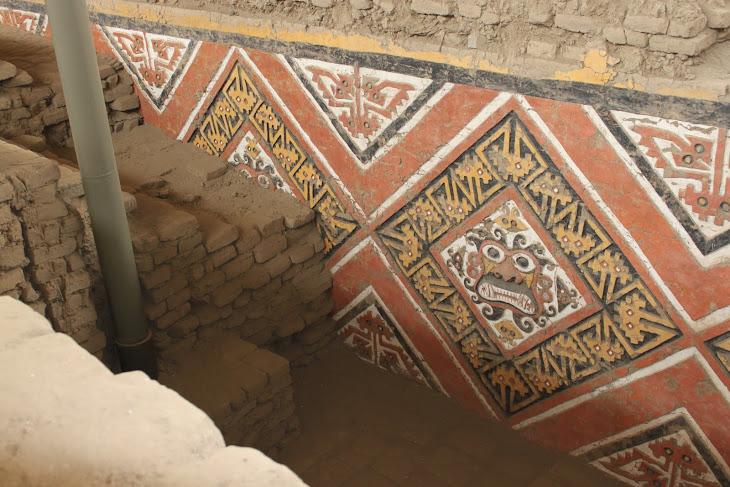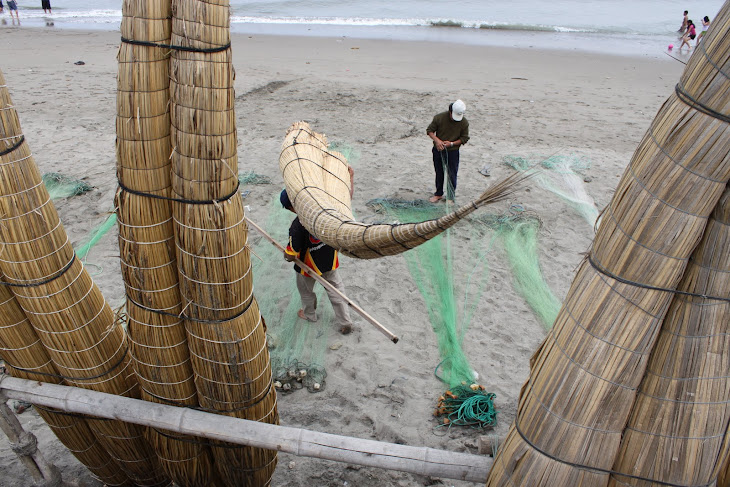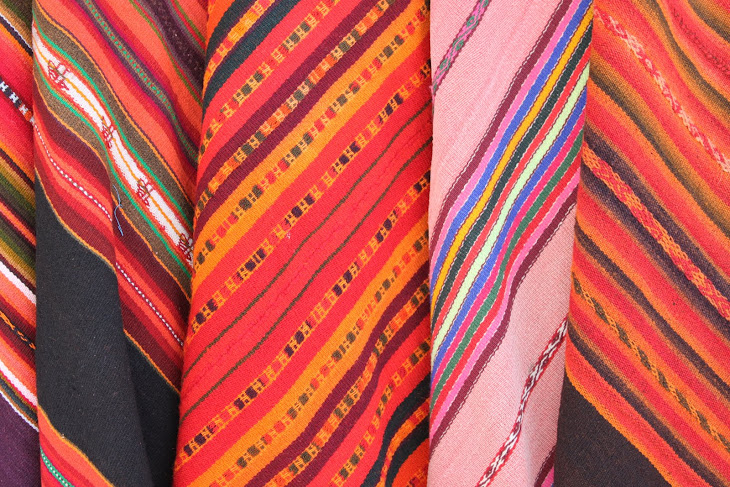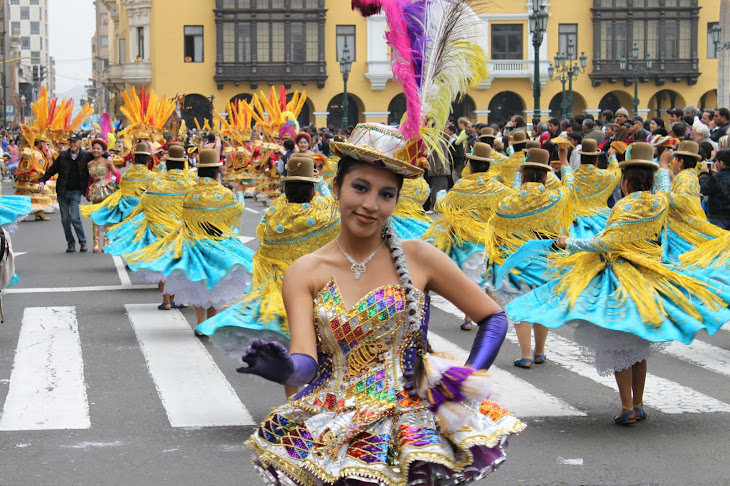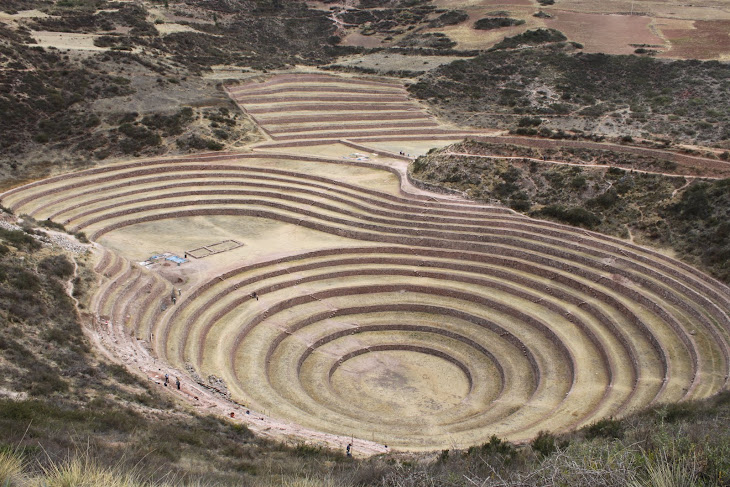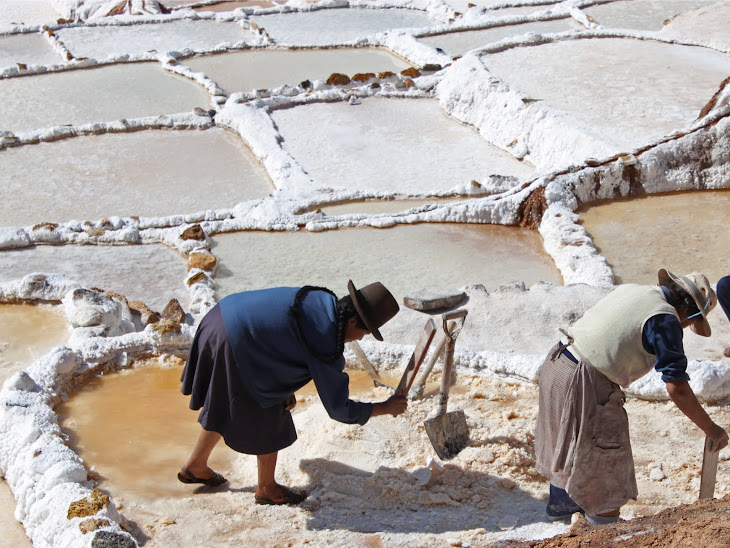We´ve spent almost a week here in Huanchaco, a very quiet fishing village just outside of Trujillo, in northern Peru. I think we´ve finally caught up on our sleep, although neither of us seem to mind the idea of another week of ¨being on vacation from our vacation¨. The highlights of Huanchaco include: strolling the deserted streets, watching the surfers from our hotel balcony, drinking oversized beers (about $2 for a 650 mL bottle), and eating lots of delicious local seafood. Karen had a stunning shrimp soup with rich golden chowder that hid a large white lump that we didn´t recognize at first. It could have been a potato, but no. We tried small bites and it didn´t taste of much but the texture was soft, not quite slimey. Maybe it was that soft bit inside a lobster claw. Then I cut it in half and a rich yellow yolk spilled into the soup. Hah. A soft-boiled egg. Delicious. At the same table, Bob had a superb cebiche of firm fresh white fish, ¨cooked¨ in lime with some heat from a tiny hot chile. Both our tummies came through the experience unscathed, which was cause for a couple of happy dances coming out of the washroom. Bob has tried several examples of chicha, a purple corn beer with cloves that´s sweet and refreshing like a sangria, and better than ¨purple corn beer¨ sounds. Every recipe is different, definitely home-made.
We´re in the nicest hotel in town. Most surfers are paying $3 a night for simpler lodgings with no view of the ocean. We couldn´t resist the cheap luxury.
We managed to go to an archeological site yesterday, the Huaca del Sol y de la Luna. A well-preserved example of Moche architecture (100 BC to 750 AD), complete with original red and blue bas relief work, which still has much restoration work remaining. We have yet to visit Chan Chan, the major Chimu site (1100 AD) in this area, but we might manage that next week between more rest days.
Saturday, September 26, 2009
Saturday, September 19, 2009
Hiking past our limits in the Sacred Valley
Just before we left, my doctor said your body will tell you when you´ve done too much. Right now, I think ít´s screaming at me. With the help of our guide (bless you Aly Amaut of Mother Earth Tours) we did five straight days of serious hiking in the Sacred Valley, including climbing two mountains. And I mean climbing -- 2.5 hours up and 2.5 hours down Putacusi for the spectacular view of Machu Picchu, which we climbed the next day beginning at 4 a.m. The first half of Putacusi included seven ladders of up to 20 metres. Then we dug out our hiking poles for the tricky uneven stone stairs to the top. It was worth it for the spectacular view, to hear Aly´s encouragement, and him calling his office from the mountain top to arrange a few more flights for us. Karen would like to thank Cheryl Carter of The Edge Personal Training for making it possible to even attempt this climb! Machu Picchu was so amazing, the rest of this year may seem a bit anticlimactic. It will certainly be less physically challenging. We didn´t get back down to town until 1 p.m. We finally left the ancient site when we ran out of water and energy in the noon sun and altitude.
During this period, we debated the next part of our plan -- Lake Titicaca and the Colca Canyon. Both of those are much higher than the altitudes we had pushed ourselves through so far. With the toll that the hiking took on us, we didn´t feel confident about going any higher. In the end, we decided to focus on a different part of Peru, still loaded with archeological treasures but at sea level, and within taxi distance of a small fishing village, where we are headed tomorrow.
During this period, we debated the next part of our plan -- Lake Titicaca and the Colca Canyon. Both of those are much higher than the altitudes we had pushed ourselves through so far. With the toll that the hiking took on us, we didn´t feel confident about going any higher. In the end, we decided to focus on a different part of Peru, still loaded with archeological treasures but at sea level, and within taxi distance of a small fishing village, where we are headed tomorrow.
Saturday, September 12, 2009
Dizzy days in Cusco
This is our sixth day in Cusco but only the second in which we could hike uphill. Karen spent most of the first two days in bed suffering from mild altitude sickness. Nothing alarming: slight headache, dizzyness and shortness of breath but she could barely walk around the level parts of this high-altitude city, much less climb the stairways that sometimes rise up for several blocks. Yesterday, though, she was all better with the help of a few huffs on a spray can of oxygen. No kidding. They sell oxygen here. That enabled us to visit Sacsayhuaman, an incredible Inca site that I've wanted to visit ever since I spotted its immense zigzag walls on GoogleEarth. Any ancient ruin you can see in a satellite photo has got to be impressive and Sacsayhuaman is beyond impressive. We spent hours wandering around and over it, taking many, many pictures. We've now got a wiggly hand signal for "give me the camera". There are two other Inca sites, each another 20-minute hike further uphill through eucalyptus forests. Ummmm . . . lovely aroma. As we left Sacsayhuaman, the clouds grew nasty dark and we were in the middle of nothing. A few shacks along the side of the trail had the usual knitwear for sale and then we saw the word "menu" over one doorway and ducked inside. The guy who welcomed us in made us a few basic sandwiches and coca tea while the rain poured down. Soon the rain stopped and we hiked on to Qenko, mostly a bare rock with some carved niches and caves. On our way to the third site, Salapunco, a couple of local kids pointed the way. Quite cheerful and didn't even ask for money, kind of unusual for this touristy town. These last two remote sites were remarkably free of tourists, in fact, we were the only ones at the last one. We then managed to wander our way home, including stumbling upon an Inca highway that led back into Cusco. Extremely cool.
One other topic: food. We had no idea that Peru was such a great place to eat. Now that our tummies are improving we've been sampling some of the most tasty meals since France five years ago. Karen loved the alpaca and plantain stew, as well as the sweet potato and parmesan ravioli. I've had Andean lake trout in 3 different styles, all fabulous. The local wine is a bit sour, but Argentinian and Chilean are everywhere. The coffee is less exciting than you might expect so we've continued to sip away at the coca tea, which does help with the altitude. Kind of like an earthy green tea.
At 7 a.m. tomorrow, we head off to the Sacred Valley and Machu Picchu so it'll probably be a while between posts . . . unless the hotels there are as well-equipped as the ones we stayed at in Lima and Cusco. Meanwhile, we'll post a few pics and-or attempt a slideshow.
One other topic: food. We had no idea that Peru was such a great place to eat. Now that our tummies are improving we've been sampling some of the most tasty meals since France five years ago. Karen loved the alpaca and plantain stew, as well as the sweet potato and parmesan ravioli. I've had Andean lake trout in 3 different styles, all fabulous. The local wine is a bit sour, but Argentinian and Chilean are everywhere. The coffee is less exciting than you might expect so we've continued to sip away at the coca tea, which does help with the altitude. Kind of like an earthy green tea.
At 7 a.m. tomorrow, we head off to the Sacred Valley and Machu Picchu so it'll probably be a while between posts . . . unless the hotels there are as well-equipped as the ones we stayed at in Lima and Cusco. Meanwhile, we'll post a few pics and-or attempt a slideshow.
Sunday, September 6, 2009
Quiet days
We've spent several quiet days in Lima, a few museums, a few naps, a few walks with little purpose. This is the goal of the year-long tour . . . gentle, leisurely visits with as little stress as possible. And it´s working. We've had a bit of gurgly tummy, but nothing harsh. We´ve walked ourselves into mild exhaustion, but again, nothing too horrid. Most travellers would not need this many days to see Lima; it may be huge but there are only a few key touristy bits. But we're enjoying the quiet get-to-know-you feeling and not having to meet any deadlines, self-imposed or otherwise. Some bits about Lima: The traffic and air pollution are disgusting. We walk along a major road and cross over a major highway to get to a restaurant district. The clouds of exhaust at that intersection are sickening. That one intersection has caused Karen to relearn the horking technique she last used 10 years ago in China. We always cross at traffic lights and even then try to accompany the local pedestrians in a group rather than attempt a crossing on our own. The walk/don´t walk lights include countdowns that start as high as 72 and as low as 12. There´s even one where the green man is animated -- he starts at a walking pace and then runs faster and faster as the time runs out; made us laugh even as we skedaddled across the street. No near-misses though. Local authorities have been preparing for several days now for independence day celebrations tonight (postponed from June due to the H1N1 flu). There´s a big park near here loaded up with equipment for the sound-and-light show. Each night while we've been sitting in nearby cafes, they´ve been blasting out snippets of the Star Wars theme, a bit of opera and a bit of trance house -- last night it was four times each. The deep bass booming out of the speakers kept setting off all the car alarms. And the loungy jazz trio we tried to listen to kept having to quit because they were drowned out by the monster speaker system in the park. Ah well, time to wake up Karen and head to the ocean.
Wednesday, September 2, 2009
Day 1 @ Lima
The fun has begun. Now that we're in Lima, we've switched from "last this" and "last that" to a day of firsts. "First beggar" got us started and we´ve now done our first sidewalk cafe and first ocean promenade. Our first nap was this morning and now it's late afternoon and we´re headed for our second nap. Strange, though, we´re just tired and not jetlagged, so we don´t feel nearly as queasy as after flying east or west. The instant switch from autumn to spring is a bit odd, and it's coolish here but not uncomfortable. We thought we were going to take it easy but we strolled for a good four hours before settling into a coffee bar with leather couches and found out just how tired we are. We're finding the architecture, urban layout and plant life reminiscent of Cuba, Spain, Mexico and even Morocco. We found a side street full of restaurants that Karen likened to the Left Bank in Paris. We'll head there after our second nap. Maybe tomorrow we'll liven up and hit a museum.
This is our first day on a Spanish keyboard and I can´t figure out the @ sign, so I put it in the title and now I can copy it as needed.
This is our first day on a Spanish keyboard and I can´t figure out the @ sign, so I put it in the title and now I can copy it as needed.
Tuesday, September 1, 2009
can't relax
It makes sense, longest road trip, highest anxiety level pre-departure. But this does seem a bit ridiculous. Both Karen and I are tossing and turning, and have been for a week. Jennifer in particular encountered us at a fluttery-out-of-control moment. Then we drank her champagne and Karen was barely able to cook, which was supposed to be a distraction. The anxiety is not because we’re unprepared. Hah. We were ready . . . early. Until our computer blew up, until Karen’s jacket tore a seam and until the mid-sized backpack decided not to hold all the stuff we thought it would. Yet all those crises were solved. All on our last day in Kitchener. For a year. We’ve been saying that word a lot. Last. Last home-cooked meal. Last visit with this friend or that relative. Last hug. Last handshake. Last beer on the deck. Last Saturday phone chat. More than a few sniffles. Last market day. Last treat from the bakery. Last quiet sit in the backyard. Meanwhile, we’re investigating a Tasmanian cottage for Christmas and a Sydney B&B for New Year’s. Just booked a Wicked van for south New Zealand. Still trying to convince Wicked (the rental agency) to paint the van as a Canadian flag. But I digress. Tomorrow nears and then we fly. Peru Chile Easter Island Tahiti Cook Islands New Zealand Australia Tasmania Thailand Bali. And then some. Next post is from the Southern Hemisphere.
Subscribe to:
Posts (Atom)
